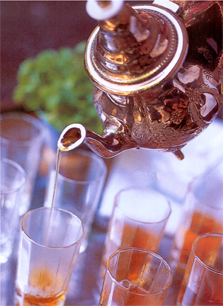Moroccan Tea

Moroccan Tea
Gunpowder green tea mixed with fresh mint, steeped in freshly boiled water. That, and a rather generous helping of sugar, is essentially all there is to Moroccan tea.
But if one actually travels to Morocco, and if one is fortunate enough to take tea with a Moroccan skilled in the traditional methods of preparation, then one quickly discovers that there is more to Moroccan tea than just tea, mint, sugar and water. Much more. Here, for our readers, is a step-by-step walk-through of the traditional process of making Moroccan tea. This is what one might expect to see if they were fortunate enough to take tea in an average, middle-class Moroccan home:
But if one actually travels to Morocco, and if one is fortunate enough to take tea with a Moroccan skilled in the traditional methods of preparation, then one quickly discovers that there is more to Moroccan tea than just tea, mint, sugar and water. Much more. Here, for our readers, is a step-by-step walk-through of the traditional process of making Moroccan tea. This is what one might expect to see if they were fortunate enough to take tea in an average, middle-class Moroccan home:
- 1. First, the guest is presented a little flask containing water and orange flower to freshen their hands. This may also be used to flavor the tea if one desires.
- Next, two silver trays are brought out, covered in muslin cloths. On one tray is placed tiny tea glasses, and a silver-plated teapot. On the other is placed a sugar bowl, a loaf of sugar, a little copper hammer, a dish containing fresh mint leaves, and a wooden box containing Chinese gunpowder green tea. If it is winter, or mint is unavailable, shiba (fresh wormwood) will be used.
- Now, a small amount of boiling water is poured into the teapot, and gently swirled around, warming the pot. Only after this step, does one add the tea and a generous portion of the mint. The pot is vigorously shaken for a brief moment, rinsing the ingredients, and the water is discarded.
- Next, the little copper hammer is used to break pieces from the sugar loaf, and these are added to the pot. A large amount of sugar is used, approximately five teaspoons per teaspoon of tea.
- Next, more boiling water is added to the pot, and it is allowed to steep for approximately four minutes.
- Next, the tea is poured into the glasses. This is done with the teapot as high above the glasses as possible, aerating the mix, and producing a highly desired froth on the surface of the tea. The Moroccan teapot is specially designed for this distance pouring, and (with considerable practice) a server can fill glasses from over a meter or more.
- The glasses are each poured back into the teapot and decanted a second time, further aerating the tea.
- Finally, the tea is served. It is quite common for other herbs and ingredients to be added to the tea at this point, including things such as lemon grass, pine nuts, orange flower, louisa, or more mint.
As you go south in Morocco, the tea becomes stronger, and the steps of preparation much less complex and formalized. However, no matter where you are in Morocco, or in what echelon of society, tea carries tremendous importance. Visitors are greeted with a cup or a glass as a sign of welcome, and gifts of tea are considered heartfelt. And at no time is the importance of tea to Moroccans more apparent, than when one sits and watches it being prepared knowing that each careful step is being done in their honor.

0 comments:
Post a Comment